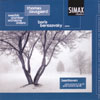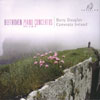Beethoven Piano Concertos Nos 2 & 4
Berezovsky’s lightness and clarity versus Douglas’s warmth and flexibility
View record and artist detailsRecord and Artist Details
Composer or Director: Ludwig van Beethoven
Genre:
Orchestral
Label: Simax
Magazine Review Date: 2/2006
Media Format: CD or Download
Media Runtime: 72
Mastering:
Stereo
DDD
Catalogue Number: PSC1280

Tracks:
| Composition | Artist Credit |
|---|---|
| Concerto for Piano and Orchestra No. 4 |
Ludwig van Beethoven, Composer
Boris Berezovsky, Piano Ludwig van Beethoven, Composer Swedish Chamber Orchestra Thomas Dausgaard, Conductor |
| Concerto for Piano and Orchestra |
Ludwig van Beethoven, Composer
Boris Berezovsky, Piano Ludwig van Beethoven, Composer Swedish Chamber Orchestra Thomas Dausgaard, Conductor |
Composer or Director: Ludwig van Beethoven
Genre:
Orchestral
Label: Satirino
Magazine Review Date: 2/2006
Media Format: CD or Download
Media Runtime: 62
Mastering:
Stereo
DDD
Catalogue Number: SR051

Tracks:
| Composition | Artist Credit |
|---|---|
| Concerto for Piano and Orchestra No. 2 |
Ludwig van Beethoven, Composer
Barry Douglas, Piano Camerata Ireland Ludwig van Beethoven, Composer |
| Concerto for Piano and Orchestra No. 4 |
Ludwig van Beethoven, Composer
Barry Douglas, Piano Camerata Ireland Ludwig van Beethoven, Composer |
Author: Rob Cowan
Barry Douglas’s version is the newest of the bunch (June 2005) and acknowledges the authentic school only fleetingly, in that his Camerata Ireland – a well groomed gathering of Ireland’s best – keep the textural calories down to a minimum. Douglas is the dreamer among the three, less digitally dazzling than Berezovsky, less classically reserved than Bronfman.
There are aspects of his performance that really made me smile: for example, at 9’33” into the first movement, where melody line and accompanying ornaments are so beautifully brought out, their roles changing places soon afterwards. Turn to Berezovsky in the same passage (about 9’09” on the Simax CD) and although the playing is crisp and fluent, it’s noticeably less colour-conscious. One imagines that Berezovsky has taken himself off with the score, studied it and come back knowing exactly what he wants, whereas Douglas sounds if he’s slept with the score and woken up loving it.
There’s a simple, expressive logic about his playing (as well as the occasional expressive desynchronisation of the hands). Try from 3’20”, where line and harmony are in perfect accord, or the unruffled calm of the Second Concerto’s slow movement, another fine performance, assertive but always considerately balanced. Camerata Ireland play well, more pristinely among the winds than the strings perhaps, but with ample character. Berezovsky uses Beethoven’s best known cadenza, Douglas its rarer, more harmonically daring option.
The real draw on Berezovsky’s disc is his revelatory account of the D major Violin Concerto-turned-Piano Concerto. Listening to it so soon after voyaging through Maxim Vengerov’s new version of the original was mildly disorienting, the first movement clocking up a mere 20’49” (as opposed to Vengerov’s 27-odd). And that’s including a four-and-a-half-minute cadenza that toys with the five drumbeats that open the work. The beauty of this performance is that it in no way attempts to make the Concerto sound like a ‘piano version’ of its violin predecessor; but, rather, takes the numerous decorative elements at face value and actually makes the work sound like a fully-fledged piano concerto.
Amusing that at a first encounter the swift solo timpani opening sounds like someone banging on a distant door. One soon adjusts to the pace – even to the slow movement, which becomes something else entirely, in a way spiritually demoted by the piano’s accompanying figurations (the soaring solo fiddle line is so incredibly effective) but it works all the same.
Fine sound from Simax, a little less good from Satirino – a full piano tone but less definition among the orchestral choirs. If pressured to choose and you’ve already invested in Bronfman, I’d stick with him – unless Douglas’s romanticism or Berezovsky’s cooler brilliance (and revealing coupling) appeal more. Gilels’s finely sculpted Philharmonia Fourth (with the Emperor) remains a ‘must-have’ purchase on the stereo-analogue front.
Discover the world's largest classical music catalogue with Presto Music.

Gramophone Digital Club
- Digital Edition
- Digital Archive
- Reviews Database
- Full website access
From £8.75 / month
Subscribe
Gramophone Full Club
- Print Edition
- Digital Edition
- Digital Archive
- Reviews Database
- Full website access
From £11.00 / month
Subscribe
If you are a library, university or other organisation that would be interested in an institutional subscription to Gramophone please click here for further information.




